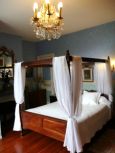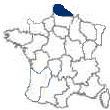The Location of Nord-Pas-de-Calais
Nord-Pas-de-Calais is
the northern most of the 22 French regions.
It lies directly south of England, and is bounded by
the North Sea to the north and northwest, Belgium to
the northeast, and
Picardy to the south.
Nord-Pas-de-Calais is composed of the départements
of
Nord and
Pas-de-Calais.
Its capital is
Lille.
The History of Nord-Pas-de-Calais
Nord-Pas-de-Calais was
originally a part of the historic provinces of
Artois, French Flanders [Flandre]
and
Picardie.
The old French province of
Artois
has been redesignated the Département of
Pas-de-Calais.
-
Artois
The name Artois, as was the name of its capital
Arras, was derived from the appellation of
the Atrebates tribe, an ancient Gallic tribe
that inhabited the area during the time of
Julius Caesar.
During the Middle Ages, from the 9th to the 12th
century,
Artois was ruled by the counts of Flanders.
This was a period that saw the province as a
prosperous manufacturing and trading center.
In 1180, the province
passed to the French king,
Philip II Augustus.
In 1237,
Louis IX made
Artois a country.
But, it remained under the influence of the
French until, in 1329, it came under the
domination of the Burgundians.
From 1500 to 1648, when it was conquered by the
French king
Louis XIII, it was ruled by the Habsburgs.
The Treaty of the Pyrénées, in 1659, the
treaties of Nijmegen, in 1678 and 1679, and the
Treaty of Utrecht, in 1713, all confirmed French
sovereignty over Artois.
World War I spelled disaster for the former
Artois. It was the scene of both Allied and German offences,
especially near Arras and Lens.
These assaults resulted in numerous towns being
extensively damaged. They were rebuilt after the war, but a lasting economic
injury had been wrought upon the area.
-
Flanders
The medieval principality of French
Flanders, in what used to be the
southwestern part of the low countries, is now
the département of
Nord.
Flanders now makes up the northeastern section
of
Nord-Pas-de-Calais
and continues to have much in common with the
neighboring low countries in terms of terrain
and the Flemish language.
In the 1st century BC, Flanders was inhabited by
the
Celts.
Over the course of the next several centuries it
was conquered and peopled by Germanic tribes.
Pagus Flandrensis predated French Flanders.
It was originally an inconspicuous district
administered by the Frankish empire.
Commencing in the 9th century, a
quasi-independent state was erected, between the
French and German kingdoms, by a line of Flemish
counts.
While
Charemagne’s empire was being broken up by
the Treaty of Verdun, the year 843 marked the
rise of Flanders.
In 862, the administrator of the pagus, Baldwin
I [Iron-Arm], married the daughter of the
Western Frankish king,
Charles II [the Bald] and was appointed
Count of Flanders.
His successors expanded the domains, between 879
and 1067, to encompass the towns of
Douai and
Arras to the south.
They also expanded eastward, across the Schelde
River, to Ghent and Antwerp. During this period, the counts had made Flanders secure
against Viking incursions.
The counts were vassals of the German kings,
with respect to their holdings east of the
Schelde, and vassals of the French kings for
their domains west of the river.
The western part of the realm, which was known
as Kroonvlaanderen [Crown Flanders], was the
most important.
Rijksvlaanderen [Imperial Flanders], to the
east, was also a part of the Holy Roman Empire.
The counts of Flanders had united a very diverse
population into a single nation.
The southern most area of Flanders was inhabited
by mainly Romance-speaking people.
To the north, the inhabitants were principally
Germanic speaking.
Along the coast were peoples of Frisian and
Saxon origin.
By the 10th century, Baldwin III had laid the
basis for an economically strong Flanders.
In 1119, the first dynasty of counts had died
out.
Under Thierry of Alsace [1128 to 1168] and his
son, Philip [1168 to 1191], a later line of
counts, the heterogeneous population of Flanders
began to attain the height of its wealth and
power.
From the 12th century, the counts brought about
a restructuring of the social order.
The old feudal structure was abandoned for a
more modern and orderly fiscal and
administrative organization.
They implemented a centralized judicial system,
based upon Roman law, and began extensive
legislation.
The granting of charters to towns, together with
the independently developing commune movement,
led to municipalities with considerable
independence.
The 12th century also marked the transition from
a purely agricultural economy to one of
international trade and industry.
The textile industry flourished through the
manufacture of English wool into high quality
cloth.
This attracted merchants of all nationalities to
Flanders.
The 13th century saw the emergence of a
distinctly Flemish culture.
Its architecture, literature and paintings
elevated it to a leading position in European
civilization.
In the 14th century, king
Philip IV, of France,
invaded and subjugated
Flanders, leaving the counts
as vassals of the French
kings.
The marriage of
Philip the Bold, Duke of
Burgundy, to
Margaret of Flanders,
the daughter of
Louis II [Count of
Flanders], made Flanders a
domain of Burgundy.
The Habsburgs gained control
of Flanders in 1477.
During the latter part of
the 16th century, Flanders
witnessed the devastating
uprising against the Spanish
Habsburgs.
Spain finally ceded Flanders
to the United Provinces of
the Netherlands, in the
early part of the 17th
century. During the late 17th and early 18th centuries, France gained
control of the region known
as French Flanders. From 1795 to 1814, during the Napoleonic period, Flanders was
incorporated into the
French Empire.
The Geography of Nord-Pas-de-Calais
Before the last Ice Age, the chalk-lands of northern
France and southern England were uninterrupted by
the English Channel that now cuts through the
Straits of Dover.
At this point, a mere 19 miles now separates England
from France.
In the north, the region is dominated by flat
lowlands, much of which is below sea level. To the south, the small hills of Avesnois and Cambrais,
rarely exceeding 650 feet in height, cross the
region from the southeast to the northwest.
Here, the landscape is primarily bocage.
The region is traversed by hundreds of rivers,
including the Authie, Canche, Escaut, Lawe, Liane,
Lys, Sambre and Scarpe, which are all navigable.
Some of these rivers are interconnected by networks
of canals.
Most of the region’s population is urban, but the
rural areas are also densely populated.
The Languages of Nord-Pas-de-Calais
Since Nord-Pas-de-Calais is one of the 22 regions of
France, French is taught and spoken everywhere in
the region. Throughout France, recognized, non-French languages, dialects
and brogues are wide spread, and many Frenchmen tend
to conserve their regional linguistic customs.
This is especially true in France’s territorial
extremities of
Brittany, Nord-Pas-de-Calais,
Alsace,
Lorraine,
Aquitaine,
Midi-Pyénées,
Languedoc-Roussillon and
Provence-Alpes-Côte d’Azur.
Brittany’s non-French language, Breton, is similar to the
Celtic languages, spoken in the western United
Kingdom.
In Alsace and Lorraine dialects, with a distinctly
Germanic flavor are in use, especially in the rural
areas.
The Basque language is widely
spoken in the southern portion of Aquitaine, and the
Midi-Pyénées, close to the Spanish boarder. In southern Languedoc-Roussillon, Catalan
is widely spoken, again near the Spanish boarder.
To the east, in the western part of
Provence-Alpes-Côte d’Azur, Occitan [Provençal] is
widely used.
Flemish,
which is commonly spoken in the region of Nord-Pas-de-Calais’
Département of Nord, in what used to be French
Flanders, is a Netherlandic dialect from the West
Germanic language group.
Netherlandic [Dutch] is also the national language
of The Netherlands and is one of the two official
languages of Belgium.
Netherlandic
is a structurally distinct branch of West Germanic,
and is differentiated from West Germanic by an
apparent anomalous development of the i-umlaut.
The 7th and 8th centuries saw this linguistic
development, as a result of the expansion of the
Merovingian and
Carolingian Franks into the coastal areas.
The preexisting coastal North Sea Germanic speakers
were unable to perfectly acquire the Frankish
pronunciation.
The Netherlandic language first took root in the
economically and culturally strong Flemish cities,
such as Ghent and Bruges, and spread rapidly through
the low countries.
The Economy of Nord-Pas-de-Calais
-
Agriculture
Much of the
region’s land is irrigated and is worked by
modern agricultural machines, employing only
a small percentage of the work force.
It produces a variety of crops, including
barley, flax, hops, oats, potatoes, sugar
beets, wheat and vegetables.
Local farms raise such livestock as cattle,
hogs and horses.
The region is a leading producer of pork.
-
Industry
Coal-mining once dominated the economy of
the region, but declined precipitously after
the Second World War. Nord-Pas-de-Calais is highly industrialized and now depends
upon imported natural gas instead of coal.
Its products include automobile parts,
chemicals, machinery, processed food,
textiles, and steel.
The highly automated textile industry, which
produces the leading manufactured products
of the region, is centered around the towns
of Armentiè,
Lille,
Roubaix and Tourcoing.
The Gastronomy of Nord-Pas-de-Calais
|



